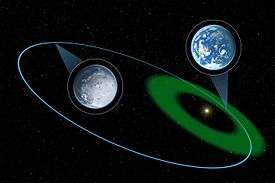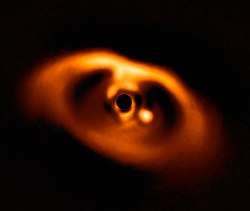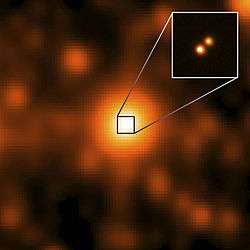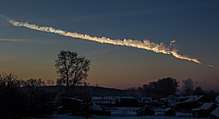Kepler-61b
Kepler-61b (also known by its Kepler Object of Interest designation KOI-1361.01) is a super-Earth exoplanet orbiting within parts of the habitable zone of the K-type main-sequence star Kepler-61. It is located about 1,100 light-years (338 parsecs) from Earth in the constellation of Cygnus. It was discovered in 2013 using the transit method, in which the dimming effect that a planet causes as it crosses in front of its star is measured, by NASA's Kepler spacecraft.
 Artistic simulation of Kepler-61b depicted as a super-Earth orbiting around its parent star. | |
| Discovery | |
|---|---|
| Discovered by | Kepler spacecraft |
| Discovery date | 24 April 2013[1] |
| Transit | |
| Orbital characteristics | |
| 0.26 AU (39,000,000 km) | |
| Eccentricity | <0.25 |
| 59.87756 d | |
| Inclination | >89.80 |
| Star | Kepler-61 (KOI-1361) |
| Physical characteristics | |
Mean radius | 2.15 (± 0.13)[2] R⊕ |
| Mass | 6.65[3] M⊕ |
| Temperature | 273 K (0 °C; 32 °F) |
Characteristics
Mass, radius and temperature
Kepler-61b is a super-Earth, an exoplanet with a radius and mass bigger than Earth, but smaller than that of the ice giants Neptune and Uranus. It has an equilibrium temperature of 273 K (0 °C; 32 °F). It has a radius of 2.15 R⊕. The mass of Kepler-61b is 6.65 M⊕. At 2.15 radius and with a 6.65 mass its density would come to around 3.6 g/cm³ or slightly below the 3.9 cm³ of Mars. This planet may also have some "volatile" make up or be an ocean planet to explain the lower density.
Host star
The planet orbits a (K-type) star named Kepler-61. The star has a mass of 0.63 M☉ and a radius of 0.62 R☉. It has a temperature of 4017 K and is about 1 billion years old. In comparison, the Sun is 4.6 billion years old[4] and has a temperature of 5778 K.[5]
The star's apparent magnitude, or how bright it appears from Earth's perspective, is 15. Therefore, it is too dim to be seen with the naked eye.
Orbit
Kepler-61b orbits its host star with about 8% of the Sun's luminosity with an orbital period of 59.877 days and an orbital radius of about 0.28 times that of Earth's (compared to Mercury from the Sun, which is about 0.38 AU). It has an eccentricity of near 0.25, meaning its orbit is mildly elliptical. It receives 27% more sunlight that Earth does.[3]
Habitability

Kepler-61b is located in the inner part of the empirical habitable zone, a zone where liquid water could exist with high albedo, relatively low humidity and higher atmospheric pressure.[6] However, the planet is likely tidally locked because of its close distance to its host star.
It has an estimated average equilibrium temperature of 273 K (0 °C; 32 °F), very close to that of Earth. If Kepler-61b is Earth-like it is a good candidate for life, because the system is about one billion years old, however because of its radius (2.24 R⊕), it is likely gaseous, with no solid surface. However, this does not totally destroy the chances of habitability in the Kepler-61 system. Kepler-61b may well have a substantially large enough Earth-like moon (with the proper atmospheric properties and pressure), capable of supporting surface liquid water, and potentially life.[7] However, such moons do not form naturally, it would have to be captured.
For a stable orbit the ratio between the moon's orbital period Ps around its primary and that of the primary around its star Pp must be < 1/9, e.g. if a planet takes 90 days to orbit its star, the maximum stable orbit for a moon of that planet is less than 10 days.[8][9] Simulations suggest that a moon with an orbital period less than about 45 to 60 days will remain safely bound to a massive giant planet or brown dwarf that orbits 1 AU from a Sun-like star.[10] In the case of Kepler-47c, this would be practically the same to have a stable orbit.
Tidal effects could also allow the moon to sustain plate tectonics, which would cause volcanic activity to regulate the moon's temperature[11][12] and create a geodynamo effect which would give the satellite a strong magnetic field.[13]
However, the orbit (and close distance to its star) of Kepler-61b may play a key in preventing it and the hypothetical moon from being habitable. The eccentricity of the planet is 0.25, which means it has an elliptical orbit. Kepler-61b's orbit takes it slightly beyond the inner edge of the habitable zone and then out to the middle of it, which would result in the planet experiencing temperatures of up to 310 K (37 °C; 98 °F) at is closest point in its orbit, and as low as 240 K (−33 °C; −28 °F) at its farthest point.[14] These temperatures may vary if Kepler-61b has an intense greenhouse effect, resulting in the planet being too hot to support liquid water altogether.
Discovery
In 2009, NASA's Kepler spacecraft was completing observing stars on its photometer, the instrument it uses to detect transit events, in which a planet crosses in front of and dims its host star for a brief and roughly regular period of time. In this last test, Kepler observed 50000 stars in the Kepler Input Catalog, including Kepler-61; the preliminary light curves were sent to the Kepler science team for analysis, who chose obvious planetary companions from the bunch for follow-up at observatories. The radial velocity observations confirmed that a planetary body was responsible for the dips observed in Kepler-61's light curve, thus confirming it as a planet. It was announced on April 24, 2013.[1]
See also
- Gliese 832 c – similar exoplanet in the habitable zone with an eccentric orbit with various temperature swings
References
- Exoplanet Characterization by Proxy: a Transiting 2.15 R_Earth Planet Near the Habitable Zone of the Late K dwarf Kepler-61 Sarah Ballard, David Charbonneau, Francois Fressin, Guillermo Torres, Jonathan Irwin, Jean-Michel Desert, Elisabeth Newton, Andrew W. Mann, David R. Ciardi, Justin R. Crepp, Christopher E. Henze, Stephen T. Bryson, Steven B. Howell, Elliott P. Horch, Mark E. Everett, Avi Shporer et al. April 26, 2013
- "Kepler-61b". Retrieved July 20, 2016.
- PHL's Exoplanets Catalog - Planetary Habitability Laboratory @ UPR Arecibo
- Fraser Cain (16 September 2008). "How Old is the Sun?". Universe Today. Retrieved 19 February 2011.
- Fraser Cain (15 September 2008). "Temperature of the Sun". Universe Today. Retrieved 19 February 2011.
- Zsom, Andras; Seager, Sara; De Wit, Julien (April 2013). "Towards the Minimum Inner Edge Distance of the Habitable Zone". The Astrophysical Journal. 1304 (2): 3714. arXiv:1304.3714. Bibcode:2013ApJ...778..109Z. doi:10.1088/0004-637X/778/2/109.
- David A. Weintraub. Religions and Extraterrestrial Life: How Will We Deal With It?. Springer. p. 64. ISBN 978-3-319-05056-0.
- Kipping, David (2009). "Transit timing effects due to an exomoon". Monthly Notices of the Royal Astronomical Society. 392: 181–189. arXiv:0810.2243. Bibcode:2009MNRAS.392..181K. doi:10.1111/j.1365-2966.2008.13999.x.
- Heller, R. (2012). "Exomoon habitability constrained by energy flux and orbital stability". Astronomy & Astrophysics. 545: L8. arXiv:1209.0050. Bibcode:2012A&A...545L...8H. doi:10.1051/0004-6361/201220003. ISSN 0004-6361.
- Andrew J. LePage. "Habitable Moons:What does it take for a moon — or any world — to support life?". SkyandTelescope.com. Retrieved 2011-07-11.
- Glatzmaier, Gary A. "How Volcanoes Work – Volcano Climate Effects". Retrieved 29 February 2012.
- "Solar System Exploration: Io". Solar System Exploration. NASA. Retrieved 29 February 2012.
- Nave, R. "Magnetic Field of the Earth". Retrieved 29 February 2012.
- http://www.hpcf.upr.edu/~abel/phl/hec_plots/hec_orbit/hec_orbit_Kepler-61_b.png



